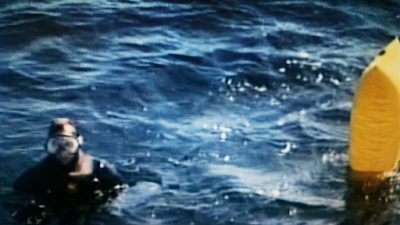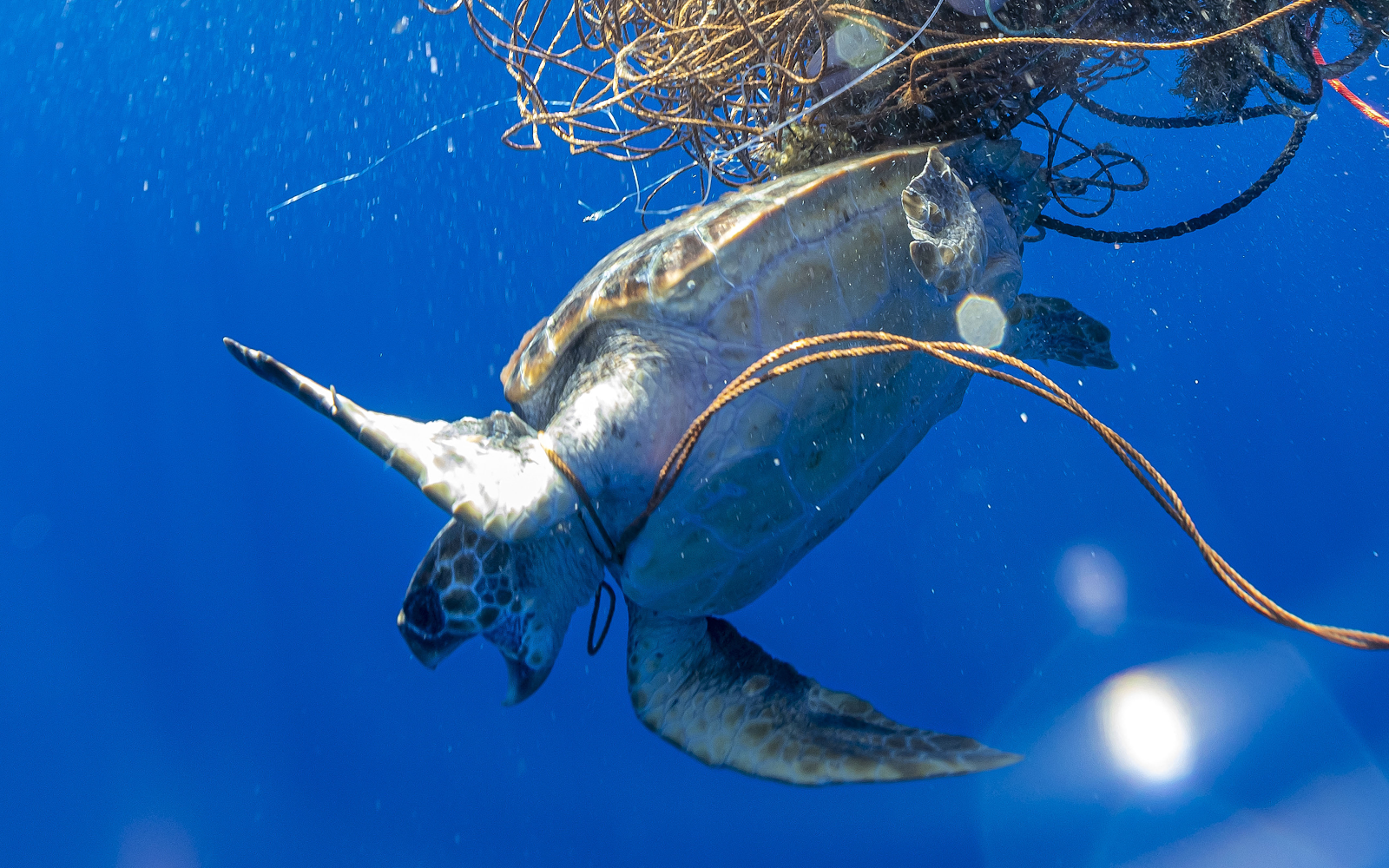Responsible Diving.
Wreck line techniques
Using nylon line without recovering it can create a deadly environmental hazard. There have been countless incidents, where turtles have been tangled in nylon line and have expired on the bottom. Some turtles have fortunately been cut free from this line and escaped with the help of divers. This publicity has raised some awareness of the losses, but below the surface an untold number go undocumented. What we can't see below the surface is the multilevel drama of suffering and waste veiled in the depths of the azure sea. Most are not as lucky and succumb to exhaustion, and drowning. If they manage to escape, they are maimed or suffer the painful effect of prolonged submergence and decompression sickness.
Besides turtles, fish, lobster, crabs, dolphins, whales, and even divers have become entangled in lines and nets. Traps also constitute a risk. Fish and lobster pots are dropped on the perimeter of wreck sites to catch species migration seeking shelter in the wreck. In a normal sequence, pots are dropped and allowed to fill for a limited period of time (within 48 hours). By law, most traps are required to have an escape vent that is large enough to let all but the legal-size lobster's escape. Traps also are equipped with runners that help prevent legs, claws and antennae from being pinched between the bottom of the trap and the boat when the traps are hauled. Most areas also require traps to have a biodegradable “ghost panel”. This panel will eventually degrade and release, allowing a large space for lobsters to escape from “ghost traps” (those that have broken free of their buoy lines and are therefore unretrievable).
Floating buoy or identification marker are to be attached to all traps in operation and must be clearly visible on the surface of the water.
Each buoy or marker attached to a trap must be of a distinctive color.
The permit number assigned to the permit holder for the current year must be painted or otherwise affixed on each buoy or marker in a contrasting color or branded on each buoy or marker.
The same permit number appearing on a buoy or marker must also be on all traps identified by that buoy or marker.
Pots or traps are required to be marked by a tag. This tag or other device should be of a material that is not deteriorated by sea water and shall be firmly attached to the pot or trap it identifies.
Traps should not be placed in designated navigation channels.
Mother nature can undo the best laid plans with a storm by breaking, tangling, and wrapping connecting lines entwining them throughout the wreckage. This creates further entrapment and snares for all venturing near including marine life and man. If the pots are not retrievable and the surface buoys cannot be reattached, cutting and recovering these lines tangled in wreckage is warranted. Cutting open doors is also acceptable for ghost traps to prevent further undue incarceration.
Recovering that nylon line, monofilament, netting, and spider fishing line helps reduce unnecessary marine life losses. Collecting the lines and proper disposal is needed to help maintain a viable environment. A small step taken by each of us can make a difference.

As with fishing laws mandating that biodegradable doors are used on traps, divers are also ethnically responsible to recover the lines they deploy. Whether it is a navigation reel of line or an emergency ascent line, reclaiming non-biodegradable line is necessary.
Problems can be increasingly attributed to using permanent nylon line for diver uses. A diver that irresponsibly pays out nylon line and does not recover it, is creating an entanglement that will kill for decades.
Problems can be increasingly attributed to using permanent nylon line for diver uses. A diver that irresponsibly pays out nylon line and does not recover it, is creating an entanglement that will kill for decades.
There are some better methods for navigation. Start navigating using your recognition skills. Understanding wreck parts and structure requires a study of ship construction. Deploying line is a cave diving technique that disables the mental process required to understand the wreck. It is an easy way to get into trouble if your line parts or is unfortunately cut. The diver recognizes his line but does not have a clue where he is in relation to the wreck. If you do pay out nylon-line, make every effort to recover it. Give yourself adequate time to reel the line in. Better yet, use biodegradable line (sisal or packing twine). This can be paid out and recovered too, but if it is left on the wreck it will disintegrate in six months to a year. Leaving a nylon trail that will remain infinite years is a result of mediocre skill and unplanned diving.
Using nylon as an emergency deco line can also create a messy and dangerous vista. When cut on the surface it drapes down weaving through the wreck as it snags all below. Thin nylon line can effortlessly whip in the current and easily coil impulsive divers prior to and during their ascent. This type of line is also slippery and difficult to maintain depth with. Sliding up past ones stop can easily happen if one is not cognizant of their buoyancy.
Using nylon as an emergency deco line can also create a messy and dangerous vista. When cut on the surface it drapes down weaving through the wreck as it snags all below. Thin nylon line can effortlessly whip in the current and easily coil impulsive divers prior to and during their ascent. This type of line is also slippery and difficult to maintain depth with. Sliding up past ones stop can easily happen if one is not cognizant of their buoyancy.
There is a common misconception is that sisal is not strong enough and too bulky too handle. Nylon is persuasively strong, but cuts and chafes easily if not locked into a fixed point. A loop in the line will cut on a sharp wreck. Divers should repetitively practice all methods of lift bag deployment to prevent this deadly error. Making your first tethered ascent should not be done during as an emergency. The boat anchor or umbilical may get pulled out or the ascent line may chafe and part at any time.
An alternative solution to lifetime line is biodegradable sisal. 1/4 sisal line has some definitive benefits for the environment. It gets a bad rap, because it is bulky, takes up a lot of room and degrades with age. Proper use and maintenance reduce some of those negatives. It has some other advantages often overlooked. It has more texture, is easy to grip and is less likely to tangle. Sisal does not need and should not be rinsed in fresh water. Saltwater does not rot the line, as with dry rot of a wooden boat, fresh water causes rot. Salt blocks were placed in boats to prevent rainwater from causing such decay. It does need to be dried out after dives to be changed seasonally to maintain integrity. In reality the upline is used only to maintain the diver or the artifact over the wreck and does not need to have more than a hundred pounds of strength. Sisal more than adequately handles these needs having several times that strength. Nylon stretches, but sisal is more taught more direct in current. Moreover, it can be deployed as a navigation line without being recovered. Within a few months it will disintegrate and break apart leaving no imprint. Whatever your choice, make responsible decisions to prevent hazardous conditions for marine life or other divers. keep you line low, wrap it frequently, and never tie to an anchor or fixed buoy. If it pulls out, it will take you with it. Plan your dive to recover what you pay out.When dives are made beyond three atmospheres, gas consumption can multiply. This is no place for unskilled, single tank divers with inadequate gas, and no multilevel redundancy. The option of drifting on a SMB is a poor choice for this type of North Atlantic wreck diving. It may be plausible for drift diving, but when traditional boat-wreck diving, it is a faulty technique. If a divers get lost and can't return to the ascent area. He should shoot a lift bag. A properly deployed lift bag will provide enough buoyancy to hang in a strong current. A one-hundred-pound bag is standard, if you are in a strong current it may require more lift. Only if they need aid, (low on gas, injured or sick, should they deploy and SMB.
The ocean is an unforgiving and unpredictable environment. Wind, wave and current continuously magnify risks. If the boat accidentally breaks free, the boat crew should start the engine (a signal to divers below, that there is a problem). The boat should remain out of gear, drift down current and place a sand anchor. All divers should cease objectives and return to the ascent area, if there is no ascent line, they should shoot a lift bag and ascend. Only after all divers up current of the boat have been recovered should the boat recover the sand anchor and search for any divers down current. Lookouts should be posted in 360 degrees on board to scan the ocean for drifting divers. If there is a missing diver, the captain should contact the Coast Guard immediately.
 |
| Be a responsible wreck diver. |
Good Wreck Diving!
Atlantic Diver











